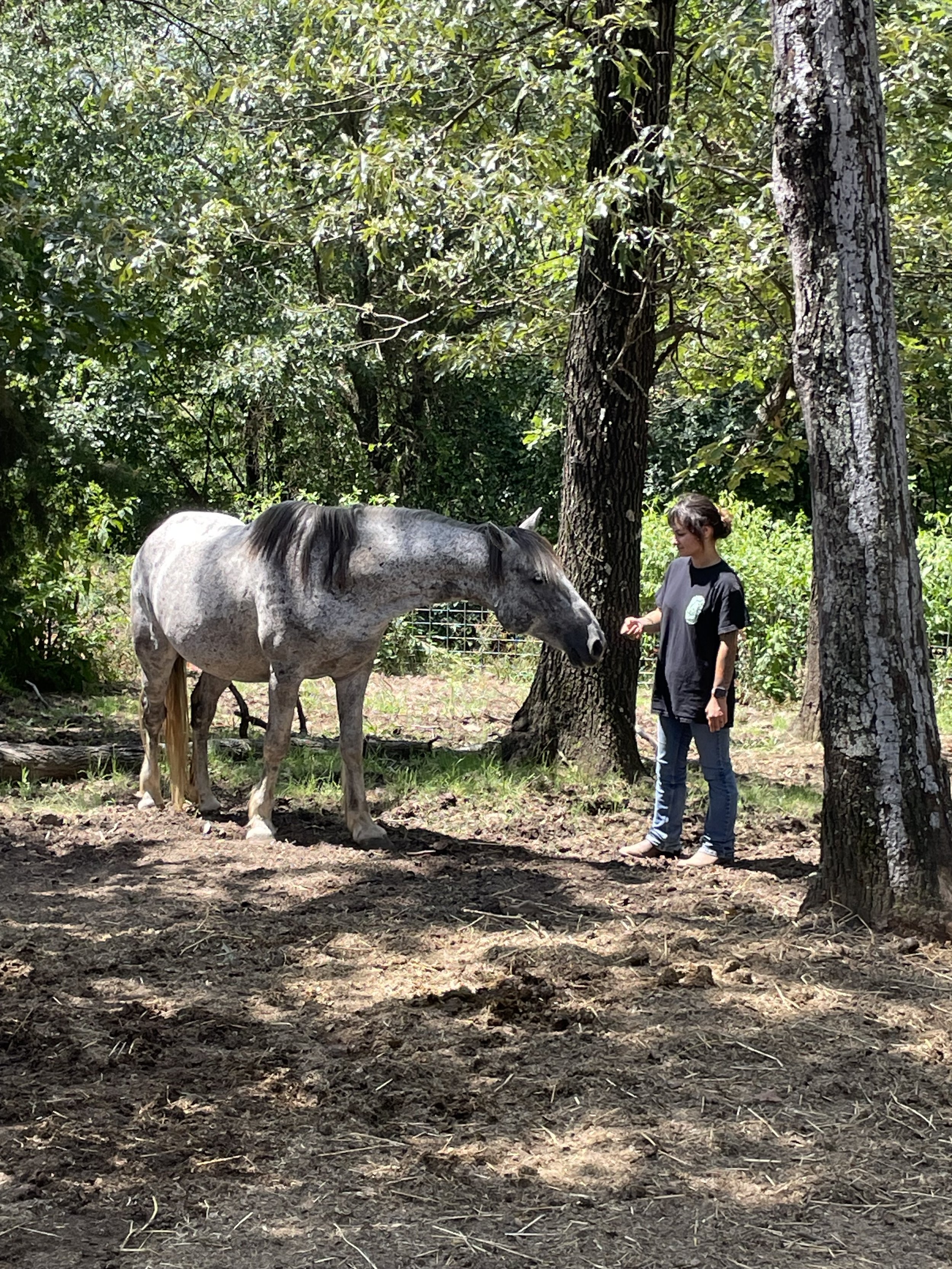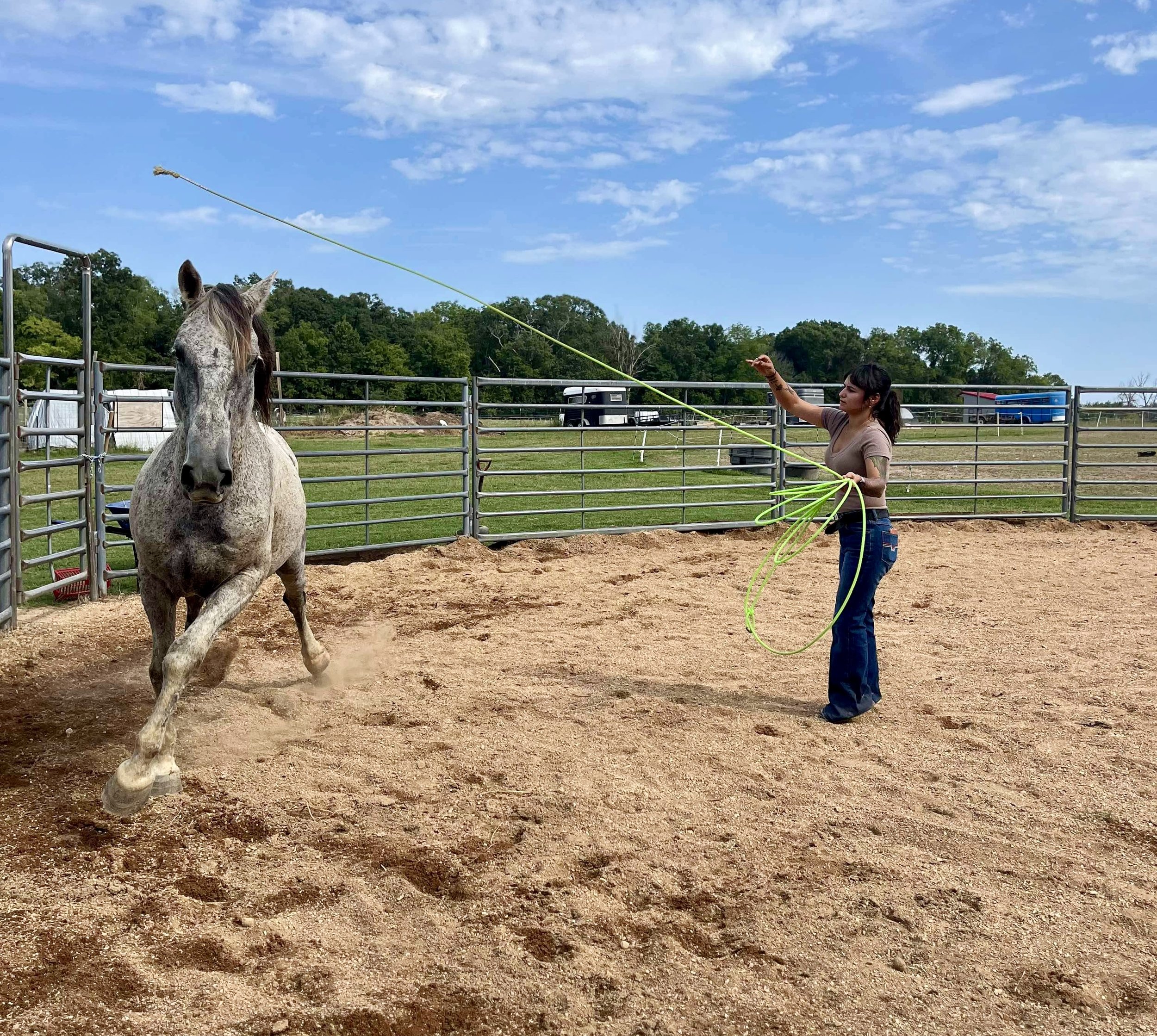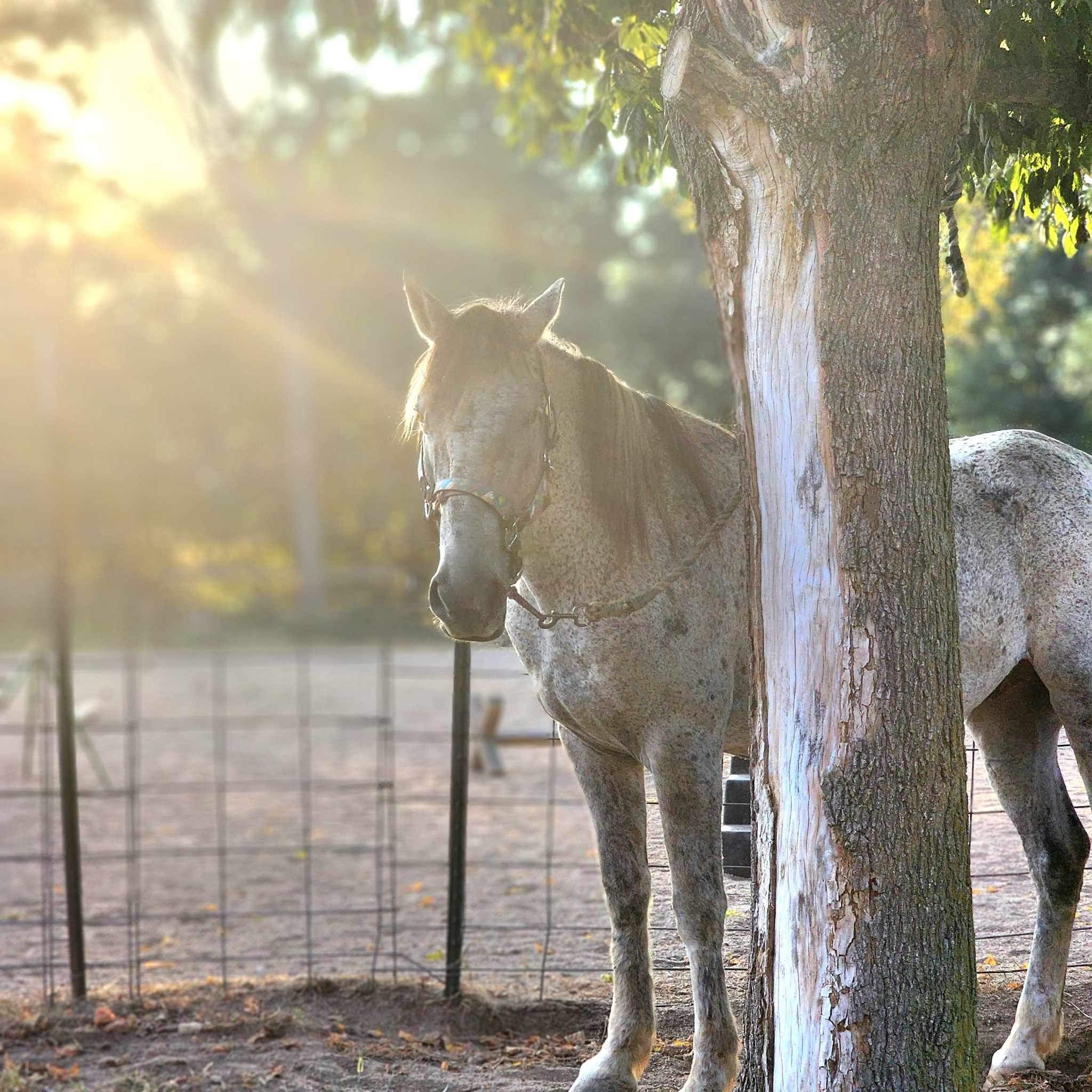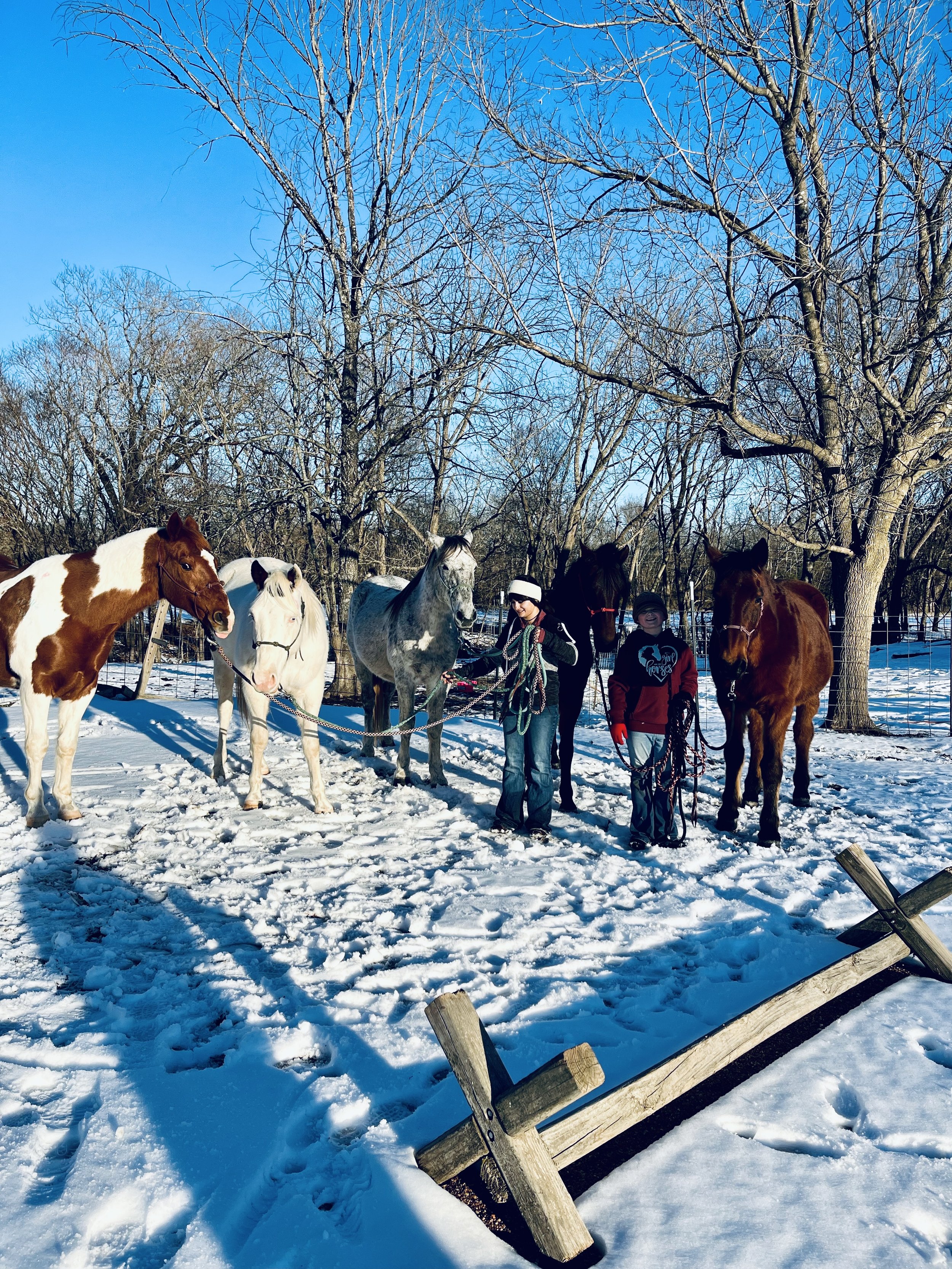My “Stop the Bleeding Project”: A Mustang’s Lesson in Safety, Survival, and Trust
Tourniquet wears a powerful brand on his neck, one of which carries strong significance in US History. A brand that carries a lot of debate, or emotion; be it political, pivotal, emotional, or even hope. The public has a small idea of what the Wild Horse and Burro program is, and while there are plenty of nuances that could be discussed here on that subject, that’s not what my platform is for, and that takes away from Tourniquets spotlight.
While his brand is very difficult to read, there are a couple of truths we can confidently assume based on his stature, presence, and of course age/mannerisms: He most likely was rounded up (not one of the few born in BLM holding pens) he probably had a family band of some kind (watching his social behavior unfold has been wildly fascinating!), and he put up for adoption to the public. His earliest experiences were shaped by conditions that an only few of our domestic horses could likely survive in! While all mustangs have differing temperaments, a lot of them adapt well to domestic life with proper training and patience. However, Tourniquet endured a little more than what some mustangs get when adopted out of the holding pens: The tension of being handled before he was ready, by the inescapable reality that humans controlled his world.
And still, he survived. Not just physically, but mentally.
Before I dive too deep into this, I have to be honest—progress with him hasn’t come easy. Every step forward comes with its own emotional highs and lows. Some days, we make strides; other days, it feels like we’re slipping five steps back. There have been rough days, emotional nights — nights where I’ve questioned everything. At what point do I stop? When do I consider another option? Should I have returned him to the rescue? The weight of those questions has never been light, and they are still questions I hold just in case he one day truly says, “I can’t”.
And I know—my persistence might look selfish to some. I’ve considered looking into Sanctuary options (which proves to be a lot harder than you would think for a variety of reasons), or what it would take for him to be just gentle enough to be a fat “pasture puff”—forever turned out and nothing asked of him. Does he deserve that, even though you can see he is curious about connection? I know I have no control over his future when I hand him off, what if they don’t care for him like I have? Maybe, in part, it has been selfish. But what he has taught me—what he continues to show me and my students about patience, presence, and what safety truly means—is worth more than any perception of his situation. His lessons aren’t just about him and what he can do for us. They’re about what we need to unlearn, where we have to soften, and what I’ve had to implement to meet him where he is. And that is worth every difficult step.
Tourniquet is one of the smartest, most intuitive horses I’ve ever met. He notices everything—small shifts in my breath, the slightest hesitation in my step, the way my energy changes before I even touch him. His awareness is razor-sharp, but it isn’t just curiosity. It’s survival.
The Weight of the Name
Tourniquet.
It came from a song by Baroness—one I found on my dad’s recently played list within the hour of his passing from a the aftermath of his heart attack. Finding that alone felt like too much to be coincidence. It was an impactful song, aching, full of something unresolved. About holding on too tightly to something that might be better released.
And my dad—he was someone who struggled under the weight of his own past, of his expectations. As I got older, I watched him wrestle with his identity, trying to redefine himself in ways that didn’t always make sense to me at the time. I see it more clearly now. He was a man who had spent so long bracing against life that maybe he never knew how to let go.
He died of a heart attack. A sudden, forceful stopping of the heart. The very thing that keeps blood flowing—keeps us alive—just… stopped. And there, on his playlist, was Tourniquet. A song about the fine line between preservation and restriction. Between holding on and letting go.
I don’t know if he saw himself in that song. I don’t know if he felt its weight the way I do now. But I do know that when I looked at this mustang, at Tourniquet, a horse who had been conditioned to brace against a world that hadn’t given him a reason to trust—it all clicked.
“A tourniquet is meant to stop the bleeding, to keep something from slipping away. But if held too tightly, for too long, it can do just as much harm as the wound itself.”
Tourniquet is what happens if you hold too tightly. He not only lives in a constant state of activation and preservation, but he sees what’s subtly braced, what’s restricted, what’s still caught in survival mode for you too. When working with him, sometimes I’m forced to ask myself—what am I still gripping onto? And what would happen if I just… let go?
The Activation I Didn’t Know I Carried
When I started working with him, I thought his hesitations, his flightiness, his tendency to walk away had everything to do with him. That’s what we’re taught, right? That the horse is the puzzle we need to solve. If they don’t trust us, we just need to prove ourselves harder.
But when Tourniquet would run and jump away, I felt it in my chest. My head would ache. I would hold my breath, not knowing whether to react or just stare.
It wasn’t just frustration—it was activation. Something deep inside me, something that had been wired for years, lit up like an alarm. Was I supposed to let him “get away with it”?
In some ways, you could say that he wasn’t just telling me what he needed. He was showing me what I was carrying.
For anyone who has known my personal “lore”, I've spent a lot of my life bracing—ready for "impact", ready for a fight or ready for the moment where I had to shut myself down to survive. When I approached Tourniquet with all that tension, all that hidden urgency, he knew. He saw it before I did. And he left. Not because he didn’t like me. Not because he was stubborn or difficult. But because he had no reason to believe that what I was offering to him was safe, what lived inside me was safe.
Neuroception: The Language of Safety
Safety isn’t something you force. You can’t talk a horse into trust, especially not one who has had to learn, over and over again, that humans are unpredictable. Tourniquet didn’t care how much I wanted him to trust me—he only cared about what I showed him.
And what I showed him, at first, was everything I hadn’t yet dropped.
This is where the mirror comes in.
How many times in my past had I not been able to escape? How many times had I been forced to stay, to endure, to reshape my reality into something survivable? When adults around me were unpredictable, when their actions made no sense, when I had no control—I had to find a way to cope, because the alternative—recognizing the full weight of what was happening—was unbearable.
That’s how the nervous system works. Neuroception, the subconscious process of detecting safety or danger, doesn’t just respond to the present—it holds onto the past. When escape isn’t an option, the body learns to survive by normalizing stress, appeasing threats, and bracing for what’s next. It stops expecting freedom and instead focuses on endurance.
Tourniquet is a mirror for this in ways that are almost too raw to put into words.
Because he doesn’t just run away when he doesn’t feel safe—he runs when I don’t feel safe. When my nervous system is still running on old programming, when my breath is shallow, when my muscles brace for something that isn’t even there anymore. He senses it. Quite the paradigm shift on having our “Feelings felt” and being understood, huh? Why would he want to stay near someone who is visibly uncomfortable? Horses don’t just respond to what we do—they respond to what we are.
Where credit is due, it should be given, and Tourniquet has been deserving of it thus far. He’s been my greatest teacher in learning how to cultivate an authentic sense of safety—not just for him, but for myself and my clients. Because the moment I stop forcing, stop gripping, stop holding on to old fears I didn’t even know I was carrying—he notices. Hell I notice. And he stays.
A Full-Circle Moment
I’ve been deep in my studies on nervous systems, trauma, and regulation, and I just finished my first Equusoma Theory Module 1 (yes, I’m bragging!). Now it’s onto the next module, and my next step as a student of Equusoma. None of this is just theory. It’s happening in real-time, every time I step into the pasture with Tourniquet.
His lessons are relentless, but they’re honest. He reminds me (as well as many others) that trust isn’t about proving—it's about presence. That safety isn’t a performance—it’s something you cultivate, breath by breath, step by step.
And I’m still learning. But for the first time, I’m not just trying to make him feel safe. I’m learning to feel safe in myself. And in that space, I think we’re both finding something we’ve never truly had before: freedom.











